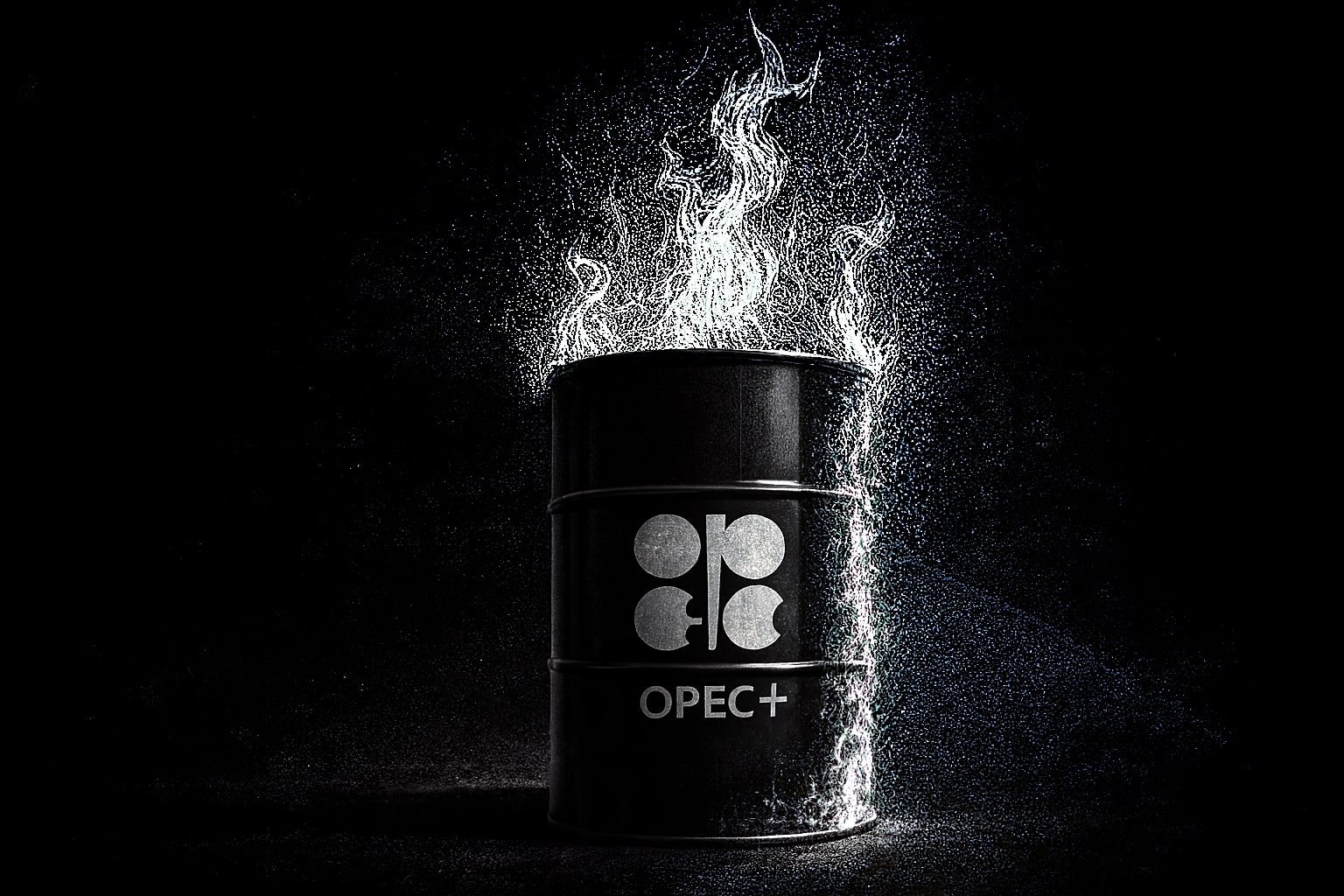OPEC+ Shocking Oil Markets: Large Output Increase and its Immediate Impact on WTI and Brent Prices
Crude oil markets were caught off guard this weekend as OPEC+ announced a significant increase in output, intensifying market concerns. On Saturday, a collective decision by Saudi Arabia, Russia, and other key producers resulted in an increase of 411,000 barrels per day (bpd) in crude oil production for June, nearly three times the initially planned hike. This move, coming on the heels of a similar surge in May, marked a sharp reversal from OPEC+'s earlier attempts to defend higher prices and suggests a pivot to a strategy focused on market share, especially targeting countries like Kazakhstan and Iraq, which have been non-compliant with their production quotas.
With Brent crude trading around $61 per barrel and WTI crude (CL=F) hovering just under $60 per barrel, the OPEC+ decision delivered an additional blow to prices, pushing them down by another 6%. This market correction has compounded existing bearish sentiment driven by global trade tensions and slowing economic data, prompting revisions in oil price forecasts from top analysts.
Goldman Sachs responded to the unexpected increase by lowering its December 2025 price forecast by $5, now projecting $66 per barrel for Brent and $62 per barrel for WTI (CL=F). This revision came in light of the renewed OPEC+ supply hike and escalating tariffs imposed by President Trump, signaling elevated risks of a global recession that would weigh further on demand. Analysts from Standard Chartered followed suit, cutting their forecast for Brent by $16, now predicting a price of $61 per barrel by 2025. The combination of rising supply and trade war fears appears to have set the stage for prolonged volatility in the oil markets.
OPEC+’s Output Increase: A Tactical Move to Punish Non-Compliant Members
OPEC+’s decision to increase output comes at a time when global oil markets are under significant pressure from weak demand and geopolitical uncertainties. Saudi Arabia, in particular, is using this increase in production as a lever to discipline countries like Kazakhstan and Iraq, who have repeatedly exceeded their production targets. Kazakhstan’s output, for instance, surpassed its March target by 422,000 bpd, further fueling tensions within the group. With Russia also pushing for compliance, OPEC+’s decision seems aimed at reasserting Saudi Arabia’s control over the market and signaling its readiness to allow prices to fall in order to bring non-compliant members into line.
OPEC+ has already slashed production by nearly 5 million bpd, and many of these cuts are scheduled to last until 2026. The strategy was originally intended to stabilize prices, but with global recession risks escalating, Saudi officials have expressed that they are unwilling to maintain higher price levels if compliance among members does not improve. This signals a more flexible approach from OPEC+, likely to keep production increases on the table if market conditions continue to worsen.
Trade Tensions and Global Demand Concerns Weighing Heavily on Oil Prices
The broader economic landscape, dominated by trade wars and tariffs, is playing a pivotal role in driving oil price volatility. U.S. President Donald Trump’s tariff strategy has not only exacerbated recession fears but also cast a shadow on global oil demand. With China’s oil imports declining and economic uncertainty on the rise, the future of oil consumption remains bleak. The WTI crude (CL=F) price has already dropped $20 per barrel from its peak, reflecting growing market apprehension.
Moreover, the OPEC+ decision to increase output despite falling prices highlights a significant shift in strategy. While Saudi Arabia has historically worked to support high prices, it now appears willing to tolerate lower price points in order to assert market control and punish overproducing members. This shift, combined with the ongoing trade war and weakening demand from key regions, paints a concerning picture for oil prices in the near term.
Chevron’s Strong Free Cash Flow Despite Oil Price Struggles
On the corporate front, companies like Chevron (NYSE: CVX) are also grappling with the effects of volatile oil prices. In the most recent quarter, Chevron reported $3.8 billion in adjusted earnings, a decrease from the previous year but still exceeding analysts' expectations. Despite the decline in crude oil prices, Chevron has demonstrated remarkable resilience, largely due to its strong portfolio of assets and efficient cost management. Chevron’s production in key regions like Kazakhstan and the Permian Basin has been increasing, and the company is seeing higher cash flow, which is being returned to shareholders through dividends and buybacks.
Chevron’s free cash flow is expected to surge in the coming year, bolstered by increased production from the Permian Basin and its Gulf of Mexico operations. While the company is cautious about its share repurchase program, lowering its buyback target for the second quarter to $2.5 billion to $3 billion, it remains a high-quality investment for those seeking consistent income through dividends. However, the company’s performance will still be closely tied to Brent crude price fluctuations, with Brent remaining in the $60 to $70 per barrel range for 2025.
The Road Ahead: What’s Next for Oil Prices and WTI (CL=F)?
As we move through the second quarter of 2025, oil prices face substantial uncertainty. OPEC+’s output increases have compounded the existing bearish sentiment, pushing Brent prices to a four-year low below $60 per barrel. With trade war fears lingering and global recession concerns growing, analysts are revising their oil price projections downward, with Goldman Sachs and Standard Chartered both slashing their price forecasts for the next few years. This suggests that the WTI crude market (CL=F) could face further headwinds, at least in the near term.
Despite these challenges, there remains significant upside potential for oil prices if global demand recovers and OPEC+ shows signs of adjusting its strategy. The likelihood of price volatility remains high, but with Saudi Arabia now signaling its readiness to let prices fall temporarily, there may be opportunities for traders to capitalize on short-term fluctuations. The key factor to watch is whether OPEC+ can enforce compliance among its members and whether the broader economic conditions will stabilize in the latter half of 2025.
The stage is set for significant volatility in the oil markets, with WTI (CL=F) and Brent crude (BZ=F) prices both at critical junctures. As OPEC+ moves forward with its strategy of output increases and market share battles, oil traders and investors must remain vigilant and prepared for a bumpy ride ahead. With recession risks lingering and supply concerns exacerbated by global trade tensions, oil prices are likely to continue their unpredictable trajectory in the coming months. The message is clear—oil prices will likely remain volatile, and the market must brace for further uncertainty.




















